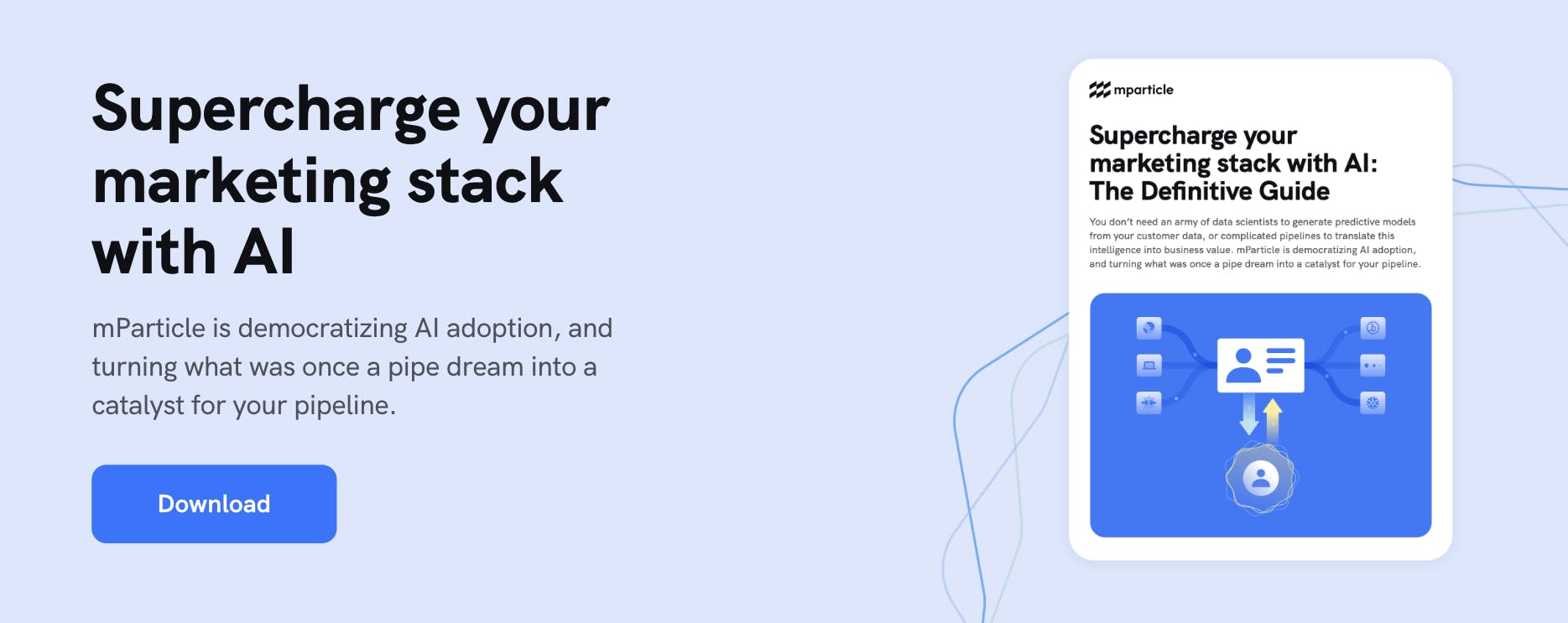How to use your customer data to predict customer churn
As the cost of acquiring new customers increases, retaining your existing customer base is becoming more important. This article walks through how you can leverage customer data to predict customer churn risk and prevent churn before it happens.

In the subscription world, churn is a part of business. Customers might stop using your product or service for all kinds of reasons—some that you have control over and some you don’t. But while some churn is inevitable, mitigating your churn rate is a key part of protecting recurring revenue, boosting customer retention, and building sustainable growth.
That endeavor has led many marketers, product managers, and more to wonder: “what if I could prevent customer churn before it happens?”
Here’s the good news: you can! But to prevent customer churn, you first need to be able to predict which customers are likely to churn—so you can target and personalize retention and re-engagement campaigns.
By using a Customer Data Platform (CDP) with Artificial Intelligence (AI) capabilities, you can automate that process, build segments of high-churn-likelihood customers, and connect those audiences with the rest of your stack to power targeted experiences across channels.
What is customer churn?
Customer churn can vary slightly depending on the dynamics of your business, but ProfitWell provides a good high-level definition:
Customer churn (or customer attrition) refers to the loss of customers or subscribers for any reason at all. Businesses measure and track churn as a percentage of lost customers compared to total number of customers over a given time period.
The percentage ProfitWill mentions is your churn rate, and it’s the inverse of your customer retention rate.
The definition is broad because there are as many reasons for churn as you have customers—each customer who leaves has their own reason for doing so. That can make understanding (and fixing) the underlying causes of churn difficult. Furthermore, win-back campaigns can be expensive.
Your best bet, therefore, is try to prevent churn before it happens.
That’s where Artificial Intelligence (AI) and predictive analytics come into play. By predicting a customer’s likelihood to churn before they actually leave, you can deliver strategic offers to at-risk customers before they switch to a competitor.
How does AI help predict churn?
Predicting churn via manual analysis is cumbersome. Plus, as your business grows, you simply can’t scale churn prediction manually. But by connecting your customer data with an AI solution, you can automate and scale churn prediction—making it a lot more realistic and useful.
To predict churn, you’ll need to historical customer data at the ready, including:
- Demographics
- Behavioral data
- Revenue and subscription data (like subscription date, plan or pricing tier, MRR at the individual customer level, etc.)
You’ll also need the right tooling in place to make use of this data. Customer Data Platforms allow you to collect customer data from all sources, automate identity resolution, data quality management, and governance, and connect data to all the other tools in your stack. By selecting a CDP with AI capabilities, you can:
- Enable marketing to generate AI insights without having to wait for data science resources
- Generate insights based on a complete, high-quality data set
- Connect insights to your CRM, analytics, and advertising systems without any development work
With access to high-quality customer data, AI models identify patterns among customers who have churned. Then, through that lens, automatically calculates the likelihood of churn for each customer profile—proactively and at scale.
Bonus points: since modeling churn is only half the battle (from there, you’ll need to take action to activate what you learn and prevent churn), you’ll also need additional activation tools (for marketing, analytics, and more) to help turn your AI predictions into campaigns to lower churn and protect revenue.
As an example, let’s walk through how you can generate churn prediction scores using AI CDP mParticle.
Predicting churn with mParticle
mParticle is a Customer Data Platform that enables teams to power their entire marketing stack with high-quality customer data. In August 2022, mParticle acquired Vidora, an AI personalization platform for customer data. The joint offering allows teams to generate AI insights without extensive development and connect them to tools throughout the stack for improved personalization.
Let’s break down the workflow for predicting customer churn with mParticle and Vidora’s Cortex AI engine step-by-step.
First, we’ll build an AI customer churn prediction model in Cortex:
- Create a new “Future Events” pipeline in Cortex, which lets you predict each user’s likelihood of taking a certain action in the future. Event types are automatically generated based on the event data ingested from mParticle.
- Set the event type as “Cancel subscription” to model churn, and set your chosen time frame. If you’re unsure, we recommend using 30 days as a good place to start.
- Check the box to include only “Subscribed” users
- Name and tag your pipeline, then double-check the summary and hit “Create Pipeline”
Once the pipeline has finished training, you can explore churn predictions within Cortex and/or export them back into mParticle, where they become intelligent attributes on each user’s profile.
- To do so, click “Deploy Pipeline” → “Export Predictions”
- Choose whether to export all users or a subset
- Select export destination as mParticle, check the boxes for both Conversion Probability and Percentile to automatically allow for predictions to appear as intelligent attributes under each user’s profile in mParticle. From there, they can be forwarded to any other output, like marketing or analytics platforms.
- Click “Save & Export” and you’re done!
How to prevent churn once you’ve predicted it
As we mentioned before, predicting which users are likely to churn is only half the battle. To meaningfully reduce your churn rate, you need to operationalize that information in a way that prevents at-risk customers from churning.
While predictive insights can tell you who is likely to churn, further analysis of historical churn and customer retention can help you understand why customers churn (and why they stick around).
That way, you can identify concrete actions you can take to reduce churn, whether that’s fixing involuntary churn, eliminating friction from the upgrade process, improving the product experience, or running proactive campaigns to boost adoption, re-engage at-risk customers, and more.
From there, churn prevention efforts fall into macro and micro buckets. On the macro side, you can make a big impact on overall churn rate by starting with the low-hanging fruit of involuntary churn (customers who didn’t actually want to churn) and addressing any high-level trends to mitigate broad swaths of customer churn.
For example, credit card expiration is a major driver of involuntary churn for many subscription companies. Build a campaign to proactively identify expiring cards and communicate with customers before the payment fails, and you can eliminate a big chunk of churn right off the bat.
On the micro level, churn predictions are even more valuable. With a single view of the customer via user profiles in mParticle, you can view the likelihood of churn at the individual level, prioritize churn mitigation efforts—based on customer value, for example—and personalize your retention and re-engagement efforts so they’re even more effective.




